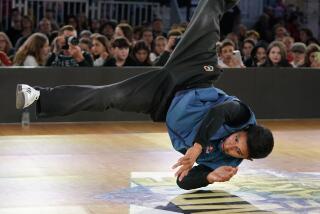This Motorcycle Event Is No Snow Job
Contrary to popular belief, the Winter X Games has only one gimmick sport, according to ESPN executives.
It’s called Moto X, or freestyle motocross, and while it has some legitimacy and a growing cult following on lowland dirt tracks, it really has no place on snow.
“We have the motocross element simply because everybody loves it,” said Chris Stiepock, X Games general manager.
What’s not to love: Daredevil athletes (read lunatics) tempting fate soaring 35 feet or more over hard-packed snow while performing aerial stunts between gaps ranging in length from 45 feet to 90 feet seems to be everyone’s idea of a good time.
Last year at Winter X, Brian Deegan of Temecula fell from the heavens like a sack of cement after letting go of his bike while trying a 360-degree rotation off the 90-foot kicker. He lay in a heap, bleeding internally, with a broken femur and two broken wrists.
Doctors put him back together and he came back this year for more in the best-trick contest, taking first place in Saturday’s preliminaries -- with a back flip with a foot release -- and winning the gold with the same trick in Sunday night’s finals.
Not advancing to the finals was Chuck Carothers, who crash-landed on top of his sideways bike while trying his signature trick: the Carolla, which involves laying out over his seat and rolling his body in mid-air.
A dazed Carothers eventually stood and raised his arms to indicate he was OK, only to be tackled by Deegan, who was apparently happy to see that his buddy was still alive.
A different breed, these Moto Xers. But then that can be said of participants of all of the X Games sports, so in that regard maybe Moto X is as real as the others.
One thing is clear: The Winter X Games, in their ninth year, have made great strides toward legitimacy since the first version featured shovel racing and ice climbing. And they’ve been immensely popular among the 20,000 or so fans who have come daily from throughout Colorado’s front-range to be part of the spectacle.
Perhaps it’s because many of them are skiers and snowboarders themselves, living in the shadow of the Rockies. Those are the mainstay sports of the X Games, which Stiepock said are “all about reflecting trends that are going out there right now in winter sports.”
Skiing is a form of racing that has been around for as long as people first strapped into the long planks. Snowboarding, a relatively new phenomenon, has become more popular than skiing in many areas and, like skiing, it is finally embraced by the Olympics.
“Snowboarding is a really good thing for the Olympics because I don’t think a lot of people can relate to a lot of the Olympic sports,” said snowboarder Kelly Clark, an Olympic gold medalist who finished fifth in the X Games superpipe finals.
“People can’t relate to bobsledding. People can’t relate to figure skating. I mean, they’re awesome athletes and so fun to watch, but you can’t actually relate to it. You can’t say, ‘I went out there and went bobsledding today.’ ”
What’s interesting is the even newer phenomenon involving skiers and snowboarders. Whereas their sports were once as different as summer and winter, their participants bitter enemies, the two are now blending into one, in a sense, and the riders are on far more amiable terms.
What’s happened, basically, is that the popularity of snowboarding led to a revolution in skiing technology, which produced a wider range of skis, including those that adapt well to terrain parks and halfpipes.
“I think what happened was that snowboarders saw skiers launching 25 feet out of the pipe and that kind of tends to give someone instant respect,” Stiepock said. “You have to give credit to guys like Tanner Hall [silver medalist in Sunday’s slopestyle competition], who aren’t afraid to enter snowboarding circles and within minutes they all realize he’s one of them.”
In slopestyle, riders are judged on a course with rails and jumps. Charles Gagnier of Victoriaville, Canada, was the winner of the skiing portion after capping a near-flawless run with a 1080-degree revolution that drew applause even from Hall.
Also on Sunday’s schedule was Ultracross, which was won by Marco Huser and Eric Andersson of Switzerland and Sweden, respectively. Ultracross, which pairs snowboarders with skiers in a relay race, is unique to X Games and considered gimmickry by some, progressive by others.
Lastly, there is snowcross, which is basically motocross on snowmobiles and is as real as it gets in the Midwest and parts of Canada, with a full-fledged tour, a TV deal and pricey sponsorships for top riders.
“We don’t get the big crowds like motocross does,” said Blair Morgan of Prince Albert, Canada. “But it’s getting bigger every year, so it’s moving forward.”
*
Seven athletes were taken to Aspen Valley Hospital on Sunday for various injuries, the most serious of which appeared to be a shoulder bruise, requiring surgery, suffered by Sweden’s Emma Furuvik in the Skier X competition.
Other reported injuries included knee ligament damage (two athletes), back sprains (two athletes), an ankle sprain and undetermined elbow and wrist injuries. Three of the athletes were practicing for snowcross, Tuesday’s featured event.
*
X GAMES ON TV
Live TV schedule for the ninth Winter X Games through Tuesday at Buttermilk Mountain near Aspen, Colo.:
TODAY
* 6-8 p.m.: Snowboard Superpipe men’s finals; SnoCross qualifying, ESPN.
More to Read
Go beyond the scoreboard
Get the latest on L.A.'s teams in the daily Sports Report newsletter.
You may occasionally receive promotional content from the Los Angeles Times.






